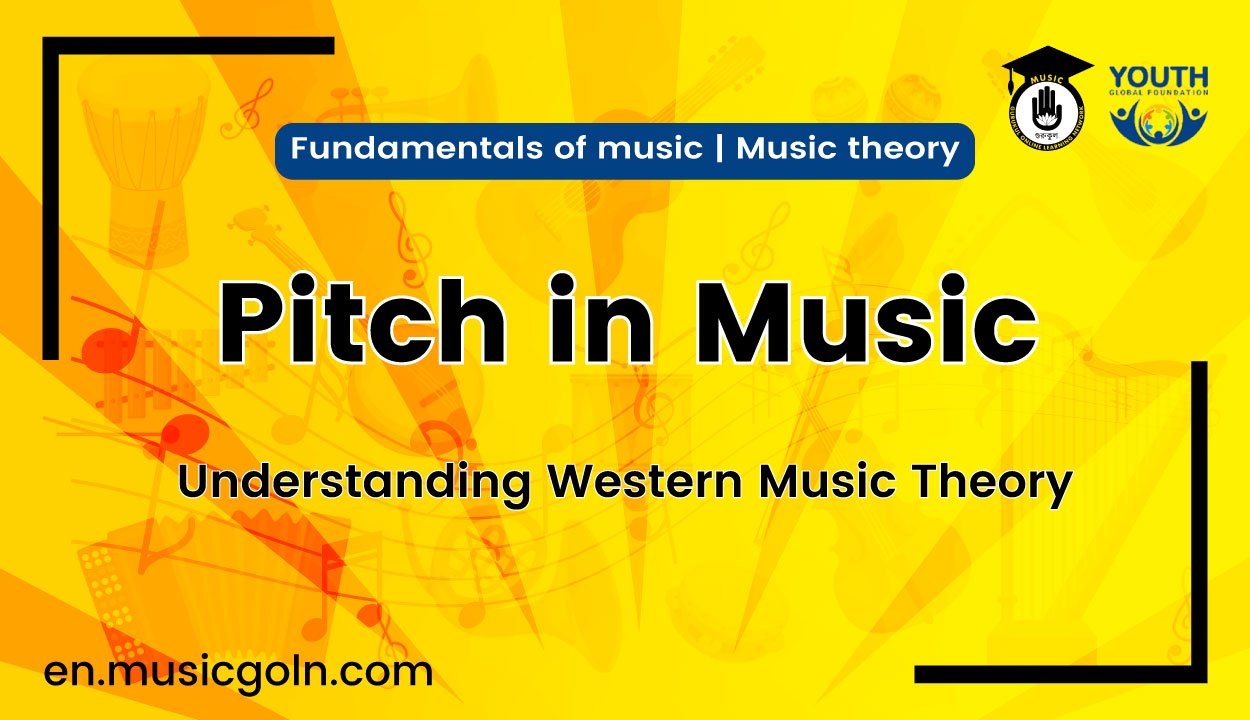Pitch in Music : Music is composed of phenomena of sound and “music theory” considers how those phenomena are and can be used in music. Music theory includes considerations of melody, rhythm, counterpoint, harmony, and form; tonal systems, scales, tuning, intervals, consonance, dissonance, durational proportions, and the acoustics of pitch systems; composition, performance, orchestration, ornamentation, improvisation, and electronic sound production; etc.
Pitch in Music

Fundamentals of music ( Pitch )
Pitch is the lowness or highness of a tone, for example the difference between middle C and a higher C. The frequency of the sound waves producing a p’itch can be measured precisely, but the perception of pitch is more complex because we rarely hear a single frequency or pure pi’tch. In music, tones, even those sounded by solo instruments or voices, are usually a complex combination of frequencies, and therefore a mix of pitches. Accordingly, theorists often describe pi’tch as a subjective sensation.
Most people appear to possess relative pit’ch, which means they perceive each note relative to some reference pitch, or as some interval from the previous pit’ch. Significantly fewer people demonstrate absolute pi’tch (or perfect pi’tch), the ability to identify pitches without comparison to another pitch. Human perception of pitch can be comprehensively fooled to create auditory illusions.
Despite these perceptual oddities, the perceived pitch is nearly always closely connected with the fundamental frequency of a note, with a lesser connection to sound pressure level, harmonic content (complexity) of the sound, and the immediately preceding history of notes heard. In general, the higher the frequency of vibration, the higher the perceived pitch. The lower the frequency, the lower the pi’tch. However, even for tones of equal intensity, perceived pitch and measured frequency do not stand in a simple linear relationship.

Intensity (loudness) can change the perception of pi’tch. Below about 1000 Hz, the perceived pit’ch gets lower as intensity increases. Between 1000 and 2000 Hz, pi’tch remains fairly constant. Above 2000 Hz, pi’tch rises with intensity. This is due to the ear’s natural sensitivity to higher-pit’ched sound, as well as the ear’s particular sensitivity to sound around the 2000–5000 Hz interval, the frequency range most of the human voice occupies.
The difference in frequency between two pitc’hes is called an interval. The most basic interval is the unison, which is simply two notes of the same pit’ch, followed by the slightly more complex octave: pit’ches that are either double or half the frequency of the other. The unique characteristics of octaves gave rise to the concept of what is called pit’ch class, an important aspect of music theory.
Pit’ches of the same letter name that occur in different octaves may be grouped into a single “class” by ignoring the difference in octaves. For example, a high C and a low C are members of the same pi’ch class—that class that contains all C’s. The concept of pi’tch class greatly aids aspects of analysis and composition.

Although pi’tch can be identified by specific frequency, the letter names assigned to pi’tches are somewhat arbitrary. For example, today most orchestras assign Concert A (the A above middle C on the piano) to the specific frequency of 440 Hz, rather than, for instance, 435HZ as it was in France in 1859. In England, that A varied between 439 and 452. These differences can have a noticeable effect on the timbre of instruments and other phenomena.
Many cultures do not attempt to standardize p’itch, often considering that it should be allowed to vary depending on genre, style, mood, etc. In the historically informed performance of older music, tuning is often set to match the tuning used in the period in which it was written. A frequency of 440 Hz was recommended as the standard pi’tch for Concert A in 1939, and in 1955 the International Organization for Standardization affirmed the choice. A440 is now widely, though not exclusively, the standard for music around the world.
P’itch is also an important consideration in tuning systems, or temperament, used to determine the intervallic distance between tones, as within a scale. Tuning systems vary widely within and between world cultures. In Western culture, there have long been several competing tuning systems, all with different qualities. Internationally, the system known as equal temperament is most commonly used today because it is considered the most satisfactory compromise that allows instruments of fixed tuning (e.g. the piano) to sound acceptably in tune in all keys.

Know more:
